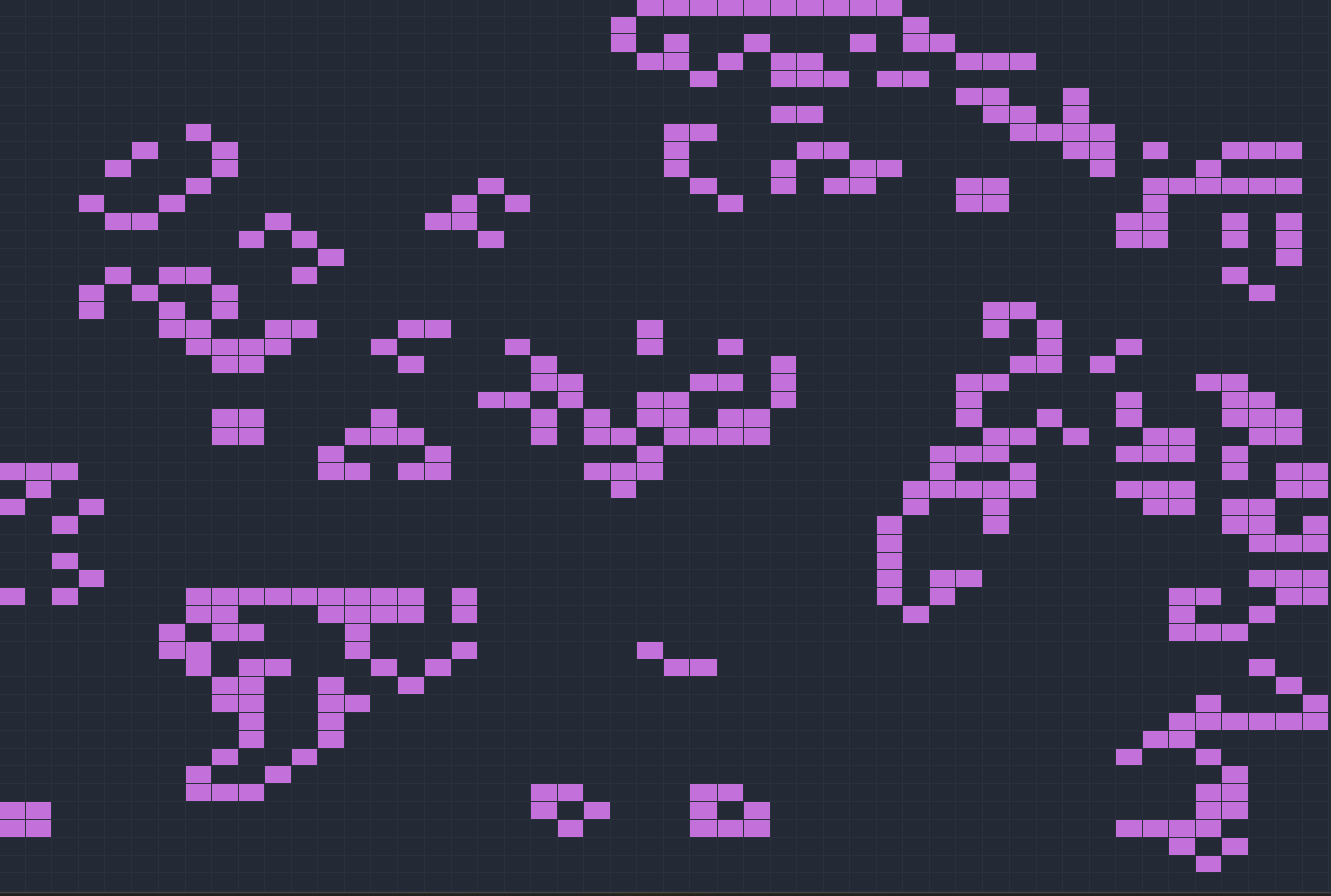
Conway's Game of Life
Conway’s Game of Life is a cellular automaton that was created by the British mathematician John Horton Conway in 1970. It is a zero-player game, meaning that its evolution is determined by its initial state, requiring no further input. One interacts with the Game of Life by creating an initial configuration and observing how it evolves.
Rules
The universe of the Game of Life is an infinite, two-dimensional orthogonal grid of square cells, each of which is in one of two possible states, live or dead. Every cell interacts with its eight neighbors, which are the cells that are horizontally, vertically, or diagonally adjacent.
At each step in time, the following transitions occur:
- Any live cell with fewer than two live neighbors dies, as if by underpopulation.
- Any live cell with two or three live neighbors lives on to the next generation.
- Any live cell with more than three live neighbors dies, as if by overpopulation.
- Any dead cell with exactly three live neighbors becomes a live cell, as if by reproduction.
These rules, which compare the behavior of the automaton to real life, can be condensed into the following:
- Any live cell with two or three live neighbors survives.
- Any dead cell with three live neighbors becomes a live cell.
- All other live cells die in the next generation. Similarly, all other dead cells stay dead.
Implementation
The Grid
In order to implement Conway’s Game of Life, we need to set a few things up. Firstly, we need to create a grid of cells, an HTML table in my case. Each cell will be a div element with a class of alive if it is alive, and no class if it is dead. We will also need to create a 2D array to store the state of each cell.
Cells also need to be easily accessible, so we will give each cell an id that is based on its row and column. This will allow us to easily access the state of any cell by using document.getElementById().
<script>
let width = 500;
let height = 500;
let cellPer = 50; // Number of cells per row and column, we want a square grid so this will be the same for both.
let cellWidth = 10;
let cellHeight = 10;
let grid = [...Array(cellPer)].map(e => Array(cellPer));
onMount(() => {
width = document.getElementById("grid-wrapper").clientWidth;
height = document.getElementById("grid-wrapper").clientHeight;
// Get a cell width and height that are more or less equal based on the width and height of the grid
cellWidth = Math.floor(width / cellPer);
cellHeight = Math.floor(height / cellPer);
});
</script>
<div id="grid-wrapper">
<table class='conway-grid-inner' id='conway-grid-inner' style='height:{height}px; width:{width}px'>
{#each Array(cellPer) as _ , i}
<tr>
{#each Array(cellPer) as _, j}
{#await genGridItem(i,j) then item}
<td id='con-{i}-{j}' class='{grid[i][j].alive ? 'alive' : ''}' style='height:{cellHeight}px; width:{cellWidth}px'>
</td>
{/await}
{/each}
</tr>
{/each}
</table>
</div>
To generate the grid, we will use a function called genGridItem that will return a promise. This function will be called for each cell in the grid, and it will return an object that represents the state of the cell. This object will have a property called alive that will be set to true if the cell is alive, and false if the cell is dead.
function genGridItem(i,j){
let alive = Math.random() < aliveInitChance ? true : false;
conwayGrid[i][j] = new ConwayCell(alive, `con-${i}-${j}`);
}
The Rules
Once we have our grid set up, we can start implementing the rules. We will create a function that will be called every n milliseconds to update the state of the grid. This function will loop through each cell and apply the rules to determine the next state of the cell.
async function playConway(){
// Generate temporary grid, we don't want to update the grid while we are still calculating the next state
let temp = [...Array(cellPer)].map(e => Array(cellPer))
// Loop over the grid
for(let row = 0; row < cellPer; row++){
for(let col = 0; col < cellPer; col++){
// Count living and dead neighbors
let count = countNeighbors(row,col);
if(!conwayGrid[row][col].alive){
// Dead cell logic
if(count == 3)
temp[row][col] = true;
else
temp[row][col] = false;
}
else{
// Live cell logic
if(count < 2 || count > 3)
temp[row][col] = false;
else
temp[row][col] = true;
}
}
}
// Replace old grid with new grid
// Prevents updates to alive prop from affecting calculations for other cells
for(let row = 0; row < cellPer; row++){
for(let col = 0; col < cellPer; col++){
conwayGrid[row][col].alive = temp[row][col];
}
}
await tick();
setTimeout(function(){
playConway();
}, delay);
}
This function creates a temporary grid that will store the next state of each cell. It then loops through each cell and calculates the number of living neighbors. Based on the number of living neighbors, it will determine the next state of the cell and store it in the temporary grid. Once all cells have been updated, the temporary grid will replace the old grid.
As you can see, the logic is fairly simple and straightforward. The only thing that is left to do is to create a function that will count the number of living neighbors for a given cell.
function countNeighbors(row, col){
let count = 0;
if(i != 0 && j != 0 && conwayGrid[i-1][j-1].alive)
count++;
if(i != 0 && conwayGrid[i-1][j].alive)
count++;
if(i != 0 && j != cellPer - 1 && conwayGrid[i-1][j+1].alive)
count++;
if(j != 0 && conwayGrid[i][j-1].alive)
count++;
if(j != 0 && i != cellPer - 1 && conwayGrid[i+1][j-1].alive)
count++;
if(i != cellPer - 1 && j != cellPer - 1 && conwayGrid[i+1][j+1].alive)
count++;
if(i != cellPer - 1 && conwayGrid[i+1][j].alive)
count++;
if(j != cellPer - 1 && conwayGrid[i][j+1].alive)
count++;
return count;
}
This function simply checks the state of each neighbor and increments a counter if the neighbor is alive. Once all neighbors have been checked, the function will return the number of living neighbors.
Conclusion
And that’s it! We now have a fully functional implementation of Conway’s Game of Life. If you want, you can add some additional features such as the ability to add or remove cells by clicking on the grid, or the ability to adjust the speed of the simulation.
You can see a live demo of the game here on my portfolio. Click on the grid to add or remove cells, and press the play button to start the simulation. You can also adjust the speed of the simulation using the slider.
I hope you enjoyed this tutorial, and I hope you have fun experimenting with Conway’s Game of Life! If you have any questions or comments, feel free to leave them below.
Happy coding!
References
- Wikipedia: Conway’s Game of Life
- Conway’s Game of Life: A great resource for learning more about Conway’s Game of Life
- Conway’s Game of Life: Another great resource for learning more about Conway’s Game of Life
